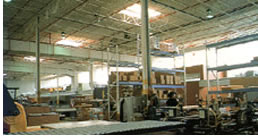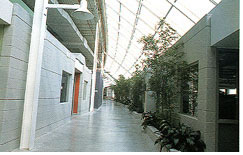
As this National Building Museum lecture shows, the public wants to know
Editor/Writer, Professional Practice
Can sustainable design be good for the environment and good for building occupants? What do organizations expect to gain when they invest in "green" buildings? These questions are finally reaching the forefront of mainstream consciousness, as evidenced by the overwhelming turnout at the National Building Museum's public seminar on green buildings, May 23 in the nation's capital. The lecture was part of the museum's "Buildings for the 21st Century" series.
 Real
and perceived benefits
Real
and perceived benefits
Judith H. Heerwagen, PhD, environmental psychologist and senior research
scientist at the Pacific Northwest National Laboratory, Richard, Wash.,
talked about the real and perceived benefits of sustainable design and
the human factors that influence the workplace and productivity.
"People actively change environments," Heerwagen said. You can design a space, but you can't design how people will use it or behave in it. Also, much of people's response to the environment is unconscious. We pay attention only when things irritate us. According to Heerwagen, how people behave toward the environment is a combination of function, people, and the environment—something designers must realize when creating workspaces to increase productivity.
Measuring productivity
The concept of productivity—the ratio between input and output—dates
back at least to the Industrial Age. Today, Heerwagen said, it may be
more relevant to look at tasks and at an organization's time to market.
 Heerwagen
talked about the most influential "mechanisms of impact" on
a building: physical, cognitive, emotional, and social. Our comfort depends
physical elements: air temperature, humidity, light, and control. Personal
or organizational elements affect comfort to lesser degrees. However,
when you are seeking to foster creativity, cognitive, emotional, and social
factors become more important.
Heerwagen
talked about the most influential "mechanisms of impact" on
a building: physical, cognitive, emotional, and social. Our comfort depends
physical elements: air temperature, humidity, light, and control. Personal
or organizational elements affect comfort to lesser degrees. However,
when you are seeking to foster creativity, cognitive, emotional, and social
factors become more important.
Although studies demonstrate that access to the natural environment is beneficial to people, Heerwagen said, in many buildings, people lack connection to time and weather. Distant views are particularly important, because they help us think and plan. Through evolutionary conditioning, we equate distance, or looking to the horizon, with the future. But these are all quality-of-life—not productivity—issues, Heerwagen reminded the audience.
Case study: Herman
Miller
To illustrate how natural features influence the workplace, Heerwagen
presented the Herman Miller SQA Headquarters in Holland, Mich. The new
headquarters incorporates lots of daylighting in its offices and factory
space, plus "interior streets" replete with skylights, plants,
and even animals—all of which evoke a sense of being outdoors.
Employees are happy with the building and perceive that they are healthier and more productive because of their improved surroundings. Heerwagen pointed out, however, that there is still no concrete data corroborating employee perception or proving that happy workers are productive workers. "Isn't it enough to have happy, healthy workers? It should be, but often it isn't," Heerwagen said. "There has to be proven productivity."
 Beyond
productivity
Beyond
productivity
Going beyond productivity, Heerwagen offered these indicators of organizational
success:
• Product quality
• Time to market
• Capacity for innovation
• Customer integration
• Employee retention
• Operational efficiency
• Social responsibility.
All these elements also figure powerfully in sustainable design, which affects an organization's strategic performance and human resource development. In the final analysis, Heerwagen concluded, for an organization to realize greater benefits and success, these aspects have to be strong. Hence, the link between sustainable design and performance appears strong, and still waiting to be proven scientifically.
For more information about the Pacific Northwest National Laboratory, visit www.pnl.gov.
Copyright 2001 The American Institute of Architects. All rights reserved.
![]()
|
|
|